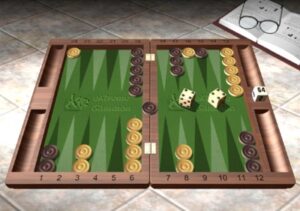Cash game, center cube.

White to play 4-4.
This position was originally Problem 166, where Black had just danced and the question was whether or not White should double. (The answer was borderline double/no double, and easy take.) Some of the responders asked how White should play a subsequent 4-4, and that did seem like an interesting idea for a problem, so here it is.
With Black on the bar, the obvious play here is 8/4(2) 6/2(2), making a 4-point board and hopefully keeping Black on the bar a while longer. However, a number of our respondents were uneasy with that play, and suggested 13/5(2) or 24/16 13/9(2) as possible alternatives. Let’s take a closer look at the position and see why making two inner points might not be the right idea here.
One key idea in middle-game play is connectivity. Basically, a position is well-connected if your checkers are relatively close together and functioning as a group. With your checkers close together, new points are easy to make and thus well-connected positions tend to lead to other well-connected positions. A full prime plus some spares rolling around the board is an extreme example of a very well-connected position.
Poorly connected positions are just the opposite; checkers are far apart and often stacked, and new points are hard to make. The starting position, with the two back checkers far away from the rest of the army, is a typical example of a poorly-connected position. One of the goals of opening play is to turn your poorly-connected position into a well-connected one by advancing the back men quickly while building some useful new points on your side of the board.
If we look at the position after 8/4(2) 6/2(2), we find that White has gained some good points, but the cooperation between his checkers is starting to suffer. Eight checkers are committed to his inner board, but his outfield is empty and the midpoint is still stacked. If Black merely enters on White’s 5-point, White will have a lot of trouble getting home without leaving shots.
Now take a look at the position after 13/5(2). White has only made one inner point rather than two, but it’s a great point. In addition, he still has a point in his outer board and some spares on the 6-point, while his midpoint is now unstacked. The checkers on the 8-point and the 6-point bear on the 4-point and 2-point. Black only has a few numbers that enter and hit White’s outfield blot, and of those only 4-4 and 1-1 are really strong shots.
In short, making the 5-point gives White a more balanced and connected position which will be easier to play in the future. Making the 4-point and the 2-point leaves White overly committed, with a position that could be hard to play.
As long as we’re talking about connectivity, what about the play that gives us the most connected position of all, namely 24/16 13/9(2)? The problem here is that connectivity isn’t the only asset we weigh in evaluating positions. If it were, this play would indeed be best; however, great points matter too, and 13/5(2) makes the very best inner point available, so it trumps the most connected play.
As a last point, let’s note that cube position factors into this problem as well. Our starting position is a marginal double/no double, and in fact White elected not to double. If he had doubled and Black had taken, then the best play with 4-4 would be to make the two inner points (although making the 5-point is only slightly inferior). In this case the gammons are live and the extra gammons that result from making two inner points would trump the better structure that 13/5(2) creates.
Backgammon is a tough game. There’s lots to think about even in a relatively straightforward position.





